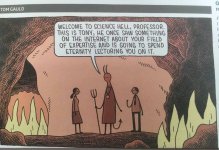Kharakov
Quantum Hot Dog
Not really, it's just that you're ignoring what you're told. <-- that's a joke.What kind of particle?
Doesn't matter. Force carrying particle. Photon. Whatever. A quantum field that extends continuously from a point in space. Whatever.
From the following diagram, if you have a rudimentary understanding of actual physical measurements and our recent conversation, you'll be able to tell that the object that went NE 1 quantized length unit then NW 1 quantized length unit will never transmit information to (and thus from) the same location in space as the particle, field source, or whatever that traveled directly north if length of space travel is quantized. Information transmission will jump over the locations of the other particle, information, field, or whatever.
1 unit of quantized length = 2 units of graph length
when the object (physically existing information, field source, particle, unterfeld, or whatever) that follows the green path starts going north again, it is either .414 or 1-.414 quantized length units from an object (information, field source, particle, unterfeld, or whatever) that went directly north the whole time (the object that followed the red path).
The top green line and red line indicate the next quantized length gap that the objects (information, field source, particle, unterfeld, or whatever) jump. The object that follows the green path will always be in a different area of quantized space, and only transmit information to places that the object that follows the red path cannot transmit information to, because it can only transmit information to quantized length portions of space away from it.
View attachment 12071
Is that a (poorly worded) proof that space cannot contain quantized lengths?
Where did you see this?
It's logic.
If length (in space) is quantized, then fields are propagated over quantized length intervals, if a particle or field source point travels the path I described (ne then nw), it will be out of sync with a particle or field source point that traveled directly north.
By out of sync, I mean as described above. If length in space is quantized, the field source point traveling north will propagate its field out of sync with the field point source that is out of sync by .414 length units because it traveled diagonally.
View attachment 12074
Also. See Weyl's tile argument above.
No. You misunderstood.
Basically, I've attempted to present an argument for the continuity of length in spacetime. If length in spacetime is not continuous, then particles with an electric charge that go off at an angle other than 0, pi/2, pi, 3pi/2 compared to a place that another particle traveled through will effectively disappear- their fields will no longer be detectable.
So in the case of non-continuous space (space that cannot be divided infinitely), we end up in a universe in which particles keep on effectively disappearing.
I've never seen the moon above China, yet for some reason.... I've never seen an electron, but for some reason... I've never seen a Chlorine atom, but for some reason..... I, and a lot of the public, have never seen Windows 10 code, but for some reason....Where have you seen this happening?
It is specifically based on the consequences of length quantization of spacetime. Either length is quantized or not. If length is quantized, the universe wouldn't exist as it is- charge would not be conserved.Is this based on an observation of a particle moving in a perfectly straight line?


